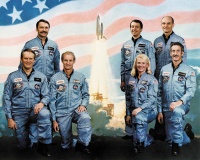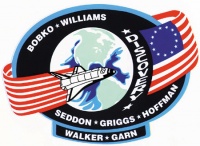STS-51D
From The Space Library
 | |
| Organization | NASA-Office of Space Flight (United States) |
|---|---|
| Mission type | Human Crew |
| Launch date | April 12, 1985 |
| Launch vehicle | Space Shuttle |
| Launch site | Cape Canaveral, United States |
| COSPAR ID | 1985-028A |
| Inclination | 28.45 degrees |
| Experiments | Here |
| Alternate Names | STS 16,15641 |
| Additional Information | Here |
| Data Collection | Here |
| Payload Mass Up | 16228 kg |
| Payload Mass Down | 6021.82 kg |
| Orbiter | Discovery |
| Lift Off Mass | 2,047,838.64 kg |
| Orbiter Weight at Liftoff | 114,041.36 kg |
| Orbiter Weight at Landing | 90,006.36 kg |
| Landed | Runway 33 at Kennedy Space Center, Fla. |
| Orbits of Earth | 109 |
| Orbital Altitude | 248 nautical miles (285 statute miles) |
Contents |
[edit] Crew
- Commander: Karol J. Bobko
- Pilot: Donald E. Williams
- Payload Commander:
- Mission Specialist 1: Jeffrey A. Hoffman
- Mission Specialist 2: S. David Griggs
- Mission Specialist 3: Margaret Rhea Seddon
- Mission Specialist 4:
- Mission Specialist 5:
- Payload Specialist 1: Charles D. Walker (as industrial payload specialist representing McDonnell Douglas Corp.)
- Payload Specialist 2: Senator Jake Garn (Utah)
ISS/Mir Crew Transport
[edit] Mission
STS 51-D was the fourth Discovery shuttle flight. On board were Karol Bobko, Donald Williams, Rhea Seddon, David Griggs, Jeffrey Hoffman, Charles Walker and US Senator Jake Garn. During this mission, the TELESAT-l (ANIK C-1) communications satellite was deployed, attached to Payload Assist Module (PAM-D) motor. SYNCOM IV-3 (also known as LEASAT-3) was deployed, but spacecraft sequencer failed to initiate antenna deployment, spin up and ignition of perigee kick motor. The mission was extended two days to make certain sequencer start lever in proper position. Griggs and Hoffman performed a space walk to attach Flyswatter devices to thr remote manipulator system. Seddon engaged LEASAT lever using remote manipulator system but post deployment sequence did not begin. Other payloads included: Continuous Flow Electrophoresis System (CFES) III, flying for sixth time; two Shuttle Student Involvement Program (SSIP) experiments; American Flight Echocardiograph (AFE); two Get Away Specials; Phase Partitioning Experiments (PPE); astronomy Photography verification test; medical experiments and `toys in space', an informal study of the behavior of simple toys in weightless environment, with results to be made available to school students. Mission duration was 167 hours 55 minutes 23 seconds.
[edit] EVA
Extravehicular Activity (EVA) conducted by Jeffrey Hoffman and David Griggs, 3 hours, 10 minutes.
[edit] Payload
Telesat (Canada communications satellite)-I with Payload Assist Module (PAM)-D deployment; Syncom IV-3 communications satellite deployment with its unique stage (unique stage failed to ignite); Continuous Flow Electrophoresis (CFES); Phase Partitioning Experiment (PPE); student experiments, two getaway specials (GAS); informal science studies (Toys in Space)
[edit] Books about the Space Shuttle Program
Buy This Book Click here |
Buy This Book here |
Buy This Book Click here |
Buy This Book Click here |





